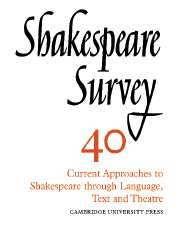Book contents
- Frontmatter
- Reconstructing Shakespeare, or Harlotry in Bardolatry
- Playing Shakespeare
- Take me to your Leda
- Sign Theory and Shakespeare
- Time in Richard III
- New Concepts of Staging A Midsummer Night’s Dream
- Henry V as Working-House of Ideology
- Shakespeare and his Sources: Observations on the Critical History of Julius Caesar
- The Speculative Eye: Problematic Self-Knowledge in Julius Caesar
- Learning by Talking: Conversation in As You Like It
- Measure for Measure: Mirror for Mirror
- Allegory and Irony in Othello
- Cruelty, King Lear and the South African Land Act 1913
- The Rationale of Current Bibliographical Methods: Printing House Studies, Computer-Aided Compositor Studies, and the Use of Statistical Methods
- Shakespeare’s Late Plays at Stratford, Ontario
- Shakespeare Performances in London, Manchester and Stratford-upon-Avon 1985–6
- The Year's Contributions to Shakespearian Study 1 Critical Studies
- 2 Shakespeare’s Life, Times, and Stage
- 3 Editions and Textual Studies
- Index
Time in Richard III
Published online by Cambridge University Press: 28 March 2007
- Frontmatter
- Reconstructing Shakespeare, or Harlotry in Bardolatry
- Playing Shakespeare
- Take me to your Leda
- Sign Theory and Shakespeare
- Time in Richard III
- New Concepts of Staging A Midsummer Night’s Dream
- Henry V as Working-House of Ideology
- Shakespeare and his Sources: Observations on the Critical History of Julius Caesar
- The Speculative Eye: Problematic Self-Knowledge in Julius Caesar
- Learning by Talking: Conversation in As You Like It
- Measure for Measure: Mirror for Mirror
- Allegory and Irony in Othello
- Cruelty, King Lear and the South African Land Act 1913
- The Rationale of Current Bibliographical Methods: Printing House Studies, Computer-Aided Compositor Studies, and the Use of Statistical Methods
- Shakespeare’s Late Plays at Stratford, Ontario
- Shakespeare Performances in London, Manchester and Stratford-upon-Avon 1985–6
- The Year's Contributions to Shakespearian Study 1 Critical Studies
- 2 Shakespeare’s Life, Times, and Stage
- 3 Editions and Textual Studies
- Index
Summary
My approach to my subject is oblique. It seems to me useful, at the cost of a brief delay, in arguing for something of an emblematic reading of Richard III, to illustrate Shakespeare's use of emblem-like properties in a work of small compass - a sonnet. Moreover, the model I have chosen serves itself as an emblem of the play.
The ostensible occasion of Shakespeare's Sonnet 77 ('Thy glass will shew thee how thy beauties wear') is the presentation as a gift of a commonplace book. The sonnet refers to three objects that bear emblematically on time: a mirror, a sundial, the book that the poem accompanies. The glass will reveal the signs of ageing, the dial will show the passage of the minutes, the blank leaves of the book will through time register the thoughts that will be committed to them. No sooner is the moralizing possibility of the objects raised in the first quatrain than the book becomes a gloss upon itself. The remaining lines express the 'learning' that the book will record. The wrinkles that the glass will show must inevitably remind the addressee of graves. The irresistible 'shady stealth' of the dial must inescapably bring to mind 'Time's thievish progress to eternity'.
- Type
- Chapter
- Information
- Shakespeare Survey , pp. 41 - 50Publisher: Cambridge University PressPrint publication year: 1988

